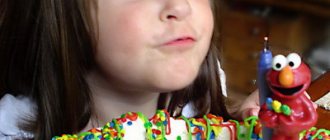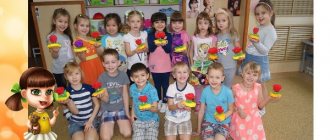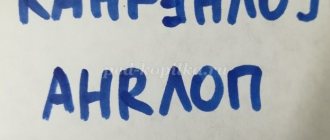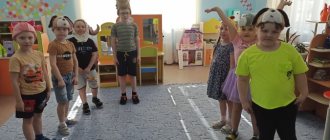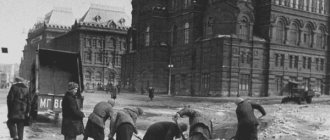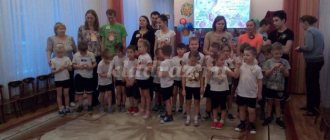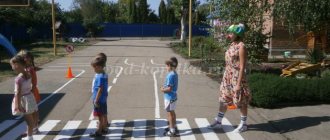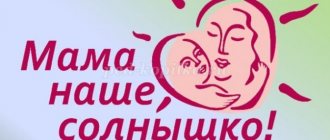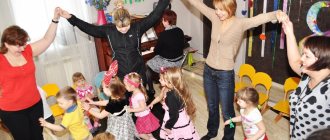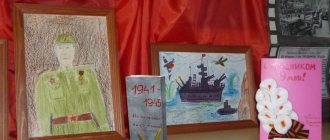Plan - summary of the Club Hour "Pasta City" in the group "Lyuboznayki"
Stage 1. Preliminary work
Enriching children's personal experience (conducting conversations, looking at illustrations, walks and excursions, reading fiction).
Preparation and collection of material to create a layout.
Stage 2.
Making the base of the layout and filling it with object material.
Stage 3. Organization of games with a layout.
| Children's activities | Forms and methods of organizing joint activities |
| Motor | Outdoor game "Good mood". Sedentary game "Three movements" Outdoor game “We are drivers.” |
| Gaming | Games with speech accompaniment. Game training “If you get lost on the street.” |
| Cognitive and research | Making a layout plan for “Our Village”, solving problem situations |
| Communicative | Conversation, guessing riddles, reading a poem. |
| Construction | Making road transport from pasta, a road sign. |
Logic of educational activities
| № | Activities of the teacher | Pupils' activities | Expected results |
| 1 | Introduction to the game situation. The teacher organizes a virtual tour of our village. | Children share their mood in a circle. | They know the rules of behavior on the street and in the yard. |
| 2 | The teacher conducts a game training “If you get lost on the street.” | Children reason and express their assumptions, solve a problem situation. | They know how to solve a problem situation and find a way out. |
| 3 | Interesting questions | Children answer questions. | Children know the rules of the road. |
| 4 | The teacher offers to play the sedentary game “Three Movements” | Children perform movements that match the color of the traffic light. | Children know the meaning of traffic lights. |
| 5 | The teacher organizes the game “We are drivers.” | Children show movements. | They know and correctly name the elements of the road. |
| 6 | The teacher invites the children to look at the layout. | Children examine, tell, describe. | Able to write a descriptive story. |
| 7 | The teacher draws attention to the letter from “Arkady Parovozov”. Invites children to read the text of the letter. | Children read the letter and draw a conclusion. | They know how to read, draw conclusions, and analyze. |
| 8 | The teacher suggests looking at the layout and asking what is missing on our street. | Children say that there are roads, streets, sidewalks, houses, but no transport. | They know how to fantasize, reason, and notice changes. |
| 9. | The teacher suggests building transport from pasta and revitalizing the streets. | Children construct vehicles from various pasta products according to a technological scheme. | They know how to correlate shapes, colors, and create intended products. |
| 9 | The teacher asks you to choose an emoticon that matches your emotions. | Children choose their own emoticons. | Children know how to choose their emotional state (using emoticons) |
Topic: Pasta city.
Integration of educational areas: “Socio-communicative development”, “Speech development”, “Physical development”, “Cognitive development”.
Tasks:
- Familiarize yourself with the rules of the road and the rules for the movement of pedestrians.
- To clarify children's knowledge about the elements of the road (roadway, pedestrian crossing, sidewalk, about traffic flow, about the operation of traffic lights.
- Continue to develop your ability to work.
- Strengthen the ability to make machines from pasta, firmly connect the parts.
- Collectively unite your crafts in accordance with a common plan, agree on who will do what part of the work.
Methods and techniques:
Practical:
- Game "Good mood"
- Mobility game “Three movements”
- Game "We are drivers"
- Solving problem situations
Visual:
- Examination of the layout.
Verbal:
- Conversation
- Reasoning
- Questions
- Reading poems
Materials and equipment: Layout “The Street of Our Village”, pictures depicting situations on the streets of the village. Road signs, different types of pasta, brushes, PVA glue, napkins, emoticons. Technological cards for the sequence of work.
Club hour “My city, my land.”
MBDOU d/s No. 96
Club hour on the theme “My city, my land.”
Goals:
- systematization of children’s knowledge about their hometown, region
- awaken in children a feeling of love for their city, region, respect for its
traditions and customs;
- cultivate respect for the culture of other peoples of the region;
- develop the need for independent exploration of the surrounding world
by studying the cultural heritage of different nations.
Tasks:
- To instill in children independence and responsibility for their actions.
- To develop children’s desire to express their attitude towards the environment, to independently find various speech means for this.
- Acquire your own life experience, experiences necessary for self-determination and self-regulation.
- Learn to take initiative in caring for others, to be grateful for help and signs of attention.
- Teach children to resolve controversial issues and resolve conflicts.
- Learn to plan your actions and evaluate their results.
- Teach children to politely express their request and thank them for the service provided.
- Encourage the child’s attempts to consciously share various impressions with the teacher and other children.
- Develop the ability to plan your actions and evaluate their results.
- To foster independence and responsibility in children.
- Learn to navigate around the kindergarten premises.
- Foster friendships between children of different ages.
- Reinforce the rules of behavior.
- Teach children how to resolve controversial issues and resolve conflicts.
Venue of the “Club Hour”: groups of pupils of secondary “A” and senior “B”, music and sports halls, offices of a psychologist, speech therapist and Ossetian language MBDOU kindergarten No. 96, Vladikavkaz
Participants: pupils of preparatory group “A”, senior group “B” and middle group “A”, parents.
Additional assistance in organizing the event: kindergarten staff, psychologist, speech therapist, physical education and Ossetian language instructors, music worker, teachers.
Club hour type: themed
Time and date: 10.00–11.00 November 10, 2021.
Resource support for the reflective circle: bags with red circles, a glowing heart, a candle, pillows, signs along the corridors and on the doors of the rooms.
Preliminary work among parents:
— inform parents about how, when and at what time the “Club Hour” will be held and how it will affect children;
— identification of prohibited places and familiarization with prohibited signs for the safety of children.
Preliminary work among teachers: prepare events for holding a club hour.
Rules aimed at the formation and development of communicative, moral, volitional qualities, self-regulation, and the ability to plan one’s actions help organize a safe and effective “Club Hour”.
For violating the rules of the club hour, the student loses the red circle that he has in his purse, there are three of them; deprivation of all the circles leads to missing the next club hour.
The rules are clear and simple:
- Say "Hello!" when meeting and “Goodbye” when parting;
- If you took a toy to play, put it back when you leave;
- Do not take toys from other children if they took it first;
- Speak calmly;
- Walk calmly;
- Return to the group when the bell rings;
- If you don’t want to go to other groups, you can stay in your own or return to it if you’re tired;
- Finish what you start.
To maintain discipline, at the beginning of Club Hour, each child is given three tokens. By breaking any rule, the child loses the token. If during the discussion during the reflective circle it turns out that the child has no tokens left, the teacher reminds that the child will spend the next club hour in a group.
The safety of children during the “Club Hour” is ensured by kindergarten teachers.
The club hour begins and ends when the bell rings.
Club hour " My city, my land "
Everyone in the world has their own little corner. For me, believe me, this is what our quiet town has become. Before, I didn’t understand and sometimes I was sad if my mother walked us home after kindergarten. We didn't want excursions, We wanted to go on the swing! But now I’m older and my interest has awakened: About my native and glorious city Find out everything, finally. Every day I look forward to when we go for a walk, Because my mother can tell me everything: About sculptures, monuments And about the Victory monument, About athletes, masters, Famous fellow countrymen... I know everything about the city, And now I understand: We should be proud of it, our native city!
Children of preparatory group "A", senior group "B" and middle group "A" gather in the music room. At the ringing of the bell, Club Hour begins.
Children were offered 7 centers:
- Architectural Center –
in the psychologist's office, where children could build a model of the future city.
2.
Cognitive center
– located in the middle group “A”, where children
got acquainted with the history of their region and built examples of historical
family towers.
- Folk workshop
– in the senior group “B”. It was possible to make dishes (from papier-mâché) with Ossetian national ornaments.
- Tourist training center -
located in the gym.
At the tourist training center, the level of preparation of children for hiking in the mountains was checked.
- People's Laboratory -
was located in the Ossetian language classroom, where children could familiarize themselves with the national ornament and decorate scarves with them. It was also possible to make a finger theater based on an Ossetian folk tale.
- City Center
- was placed in the speech therapist’s office, where it was possible to make a city map from available material.
- Game center
-
located in the music room. Here children could voice their favorite melodies on various instruments and play Ossetian rhythmic games.
After the end of the club hour, all the participating children gather in the hall, sit in a circle on pillows and the discussion begins - “Reflective circle. At the “Reflective Circle”, children share their impressions and talk about where they have been, what they did, what they did, what they liked and what they didn’t, express their wishes and where else they would like to go
During the club hour, it was noted that the emotional background of the children increased, which led to an increase in their activity in the cognitive sphere. The knowledge acquired during the club hour became more durable. Parents were active assistants of the club hour; this helped to implement an important task of the Federal State Educational Standard for Education: increasing the competence of parents in matters of raising and educating children.
